Abstract
The possible relationship of selenium to immunological function which has been suggested for decades was investigated in studies on selenium metabolism in human T cells. One of the major 75Se-labeled selenoproteins detected was purified to homogeneity and shown to be a homodimer of 55-kDa subunits. Each subunit contained about 1 FAD and at least 0.74 Se. This protein proved to be thioredoxin reductase (TR) on the basis of its catalytic activities, cross-reactivity with anti-rat liver TR antibodies, and sequence identities of several tryptic peptides with the published deduced sequence of human placental TR. Physicochemical characteristics of T-cell TR were similar to those of a selenocysteine (Secys)-containing TR recently isolated from human lung adenocarcinoma cells. The sequence of a 12-residue 75Se-labeled tryptic peptide from T-cell TR was identical with a C-terminal-deduced sequence of human placental TR except that Secys was present in the position corresponding to TGA, previously thought to be the termination codon, and this was followed by Gly-499, the actual C-terminal amino acid. The presence of the unusual conserved Cys-Secys-Gly sequence at the C terminus of TR in addition to the redox active cysteines of the Cys-Val-Asn-Val-Gly-Cys motif in the FAD-binding region may account for the peroxidase activity and the relatively low substrate specificity of mammalian TRs. The finding that T-cell TR is a selenoenzyme that contains Se in a conserved C-terminal region provides another example of the role of selenium in a major antioxidant enzyme system (i.e., thioredoxin-thioredoxin reductase), in addition to the well-known glutathione peroxidase enzyme system.
Full text
PDF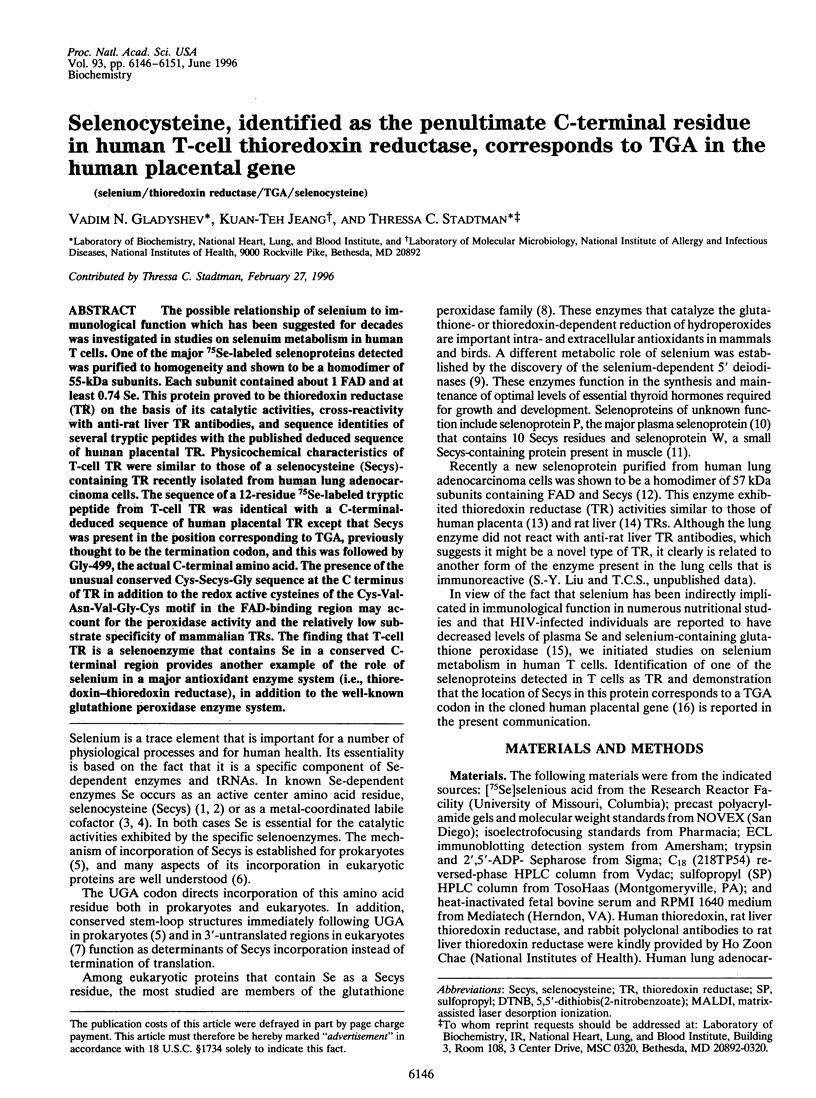
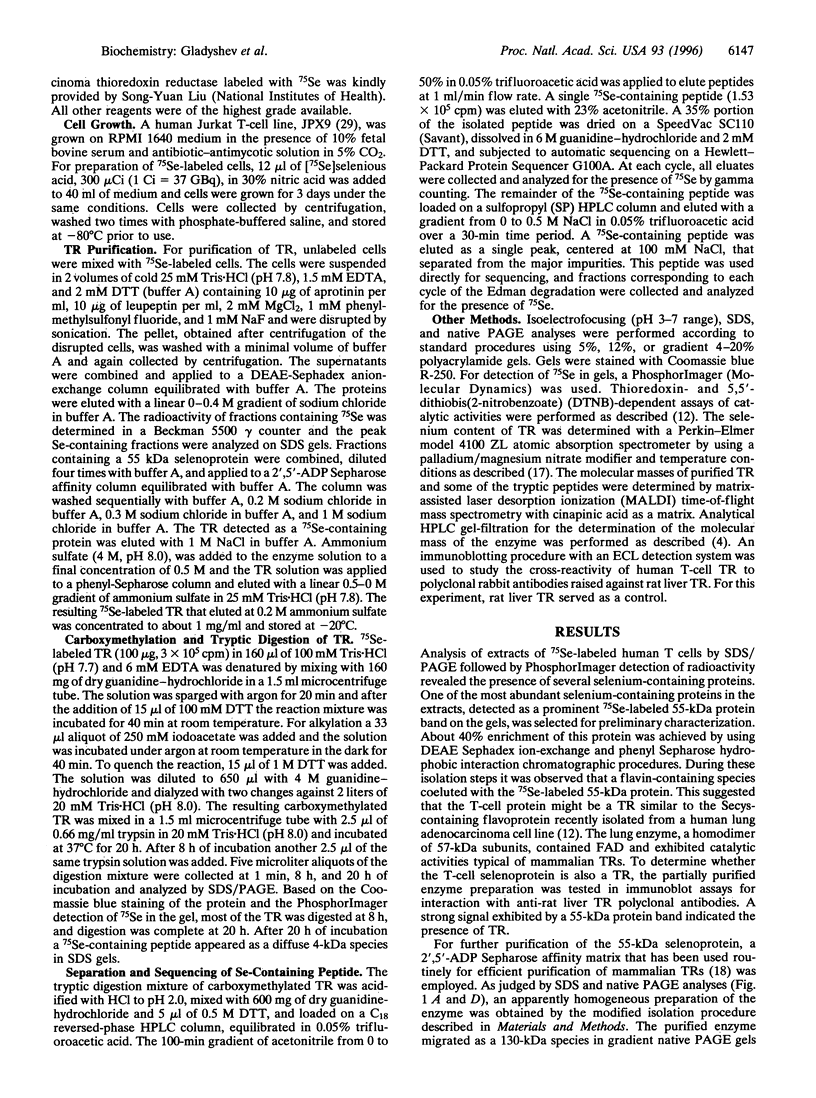
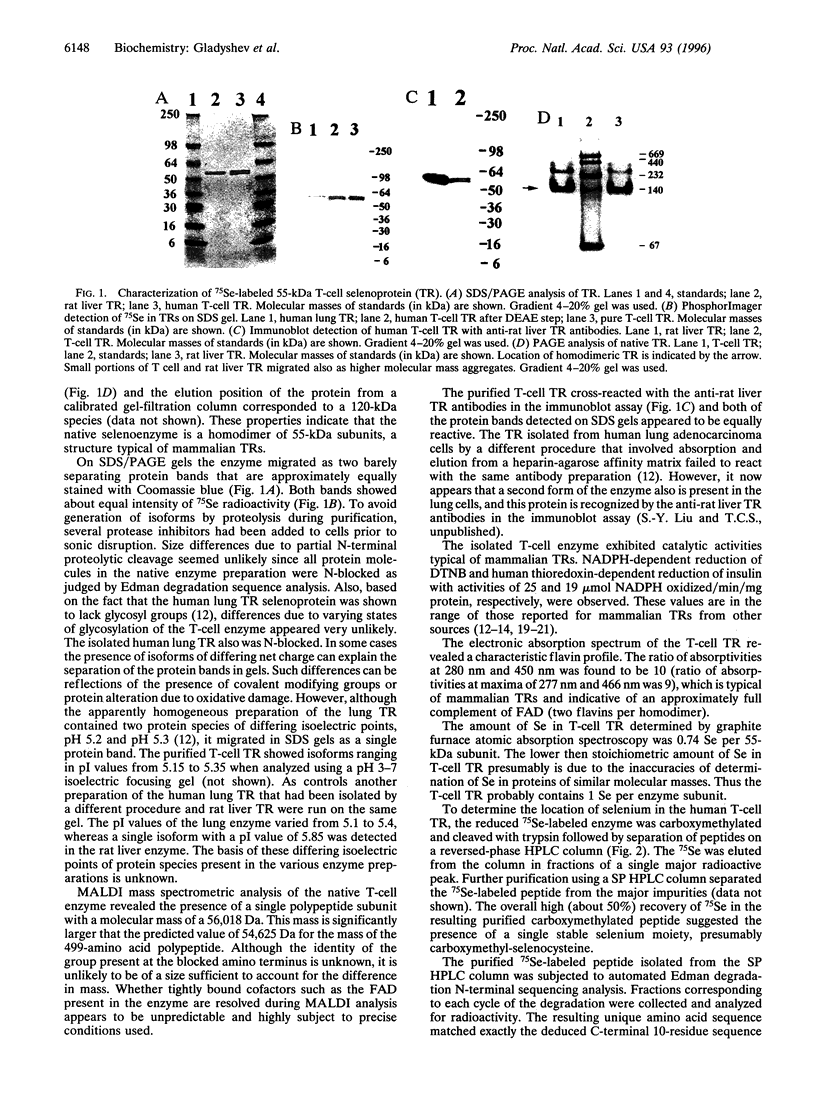
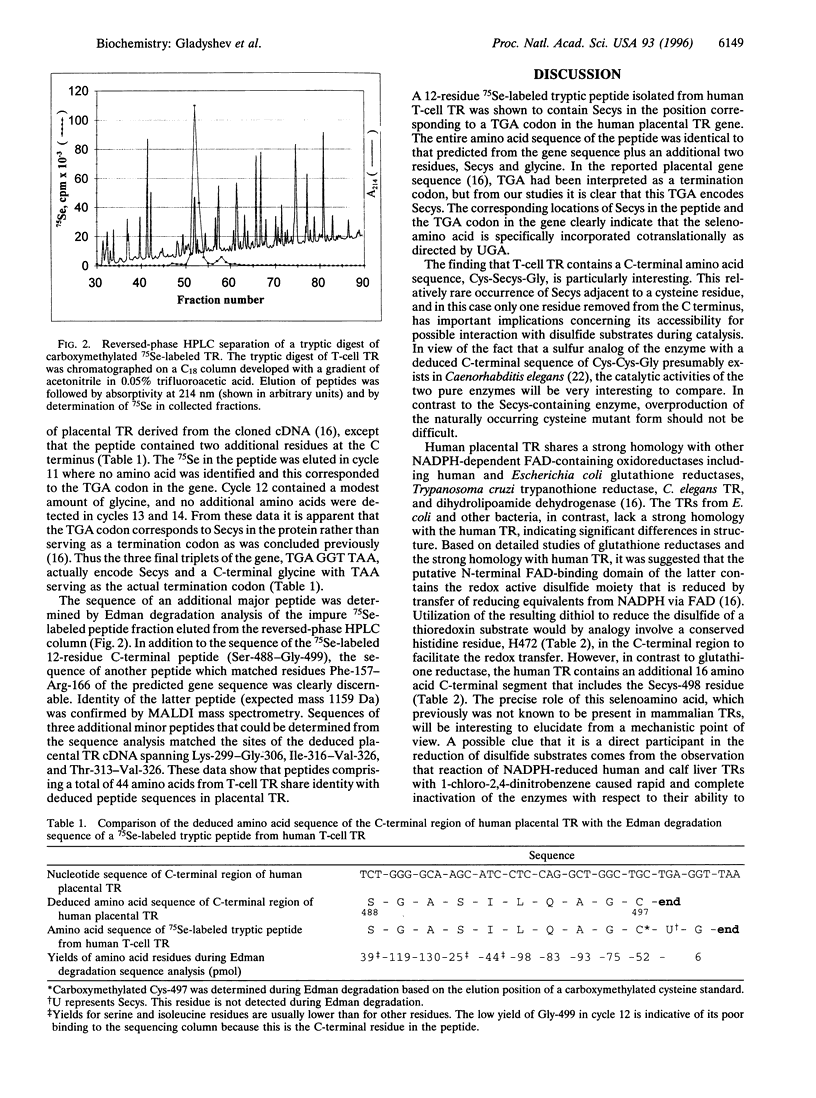
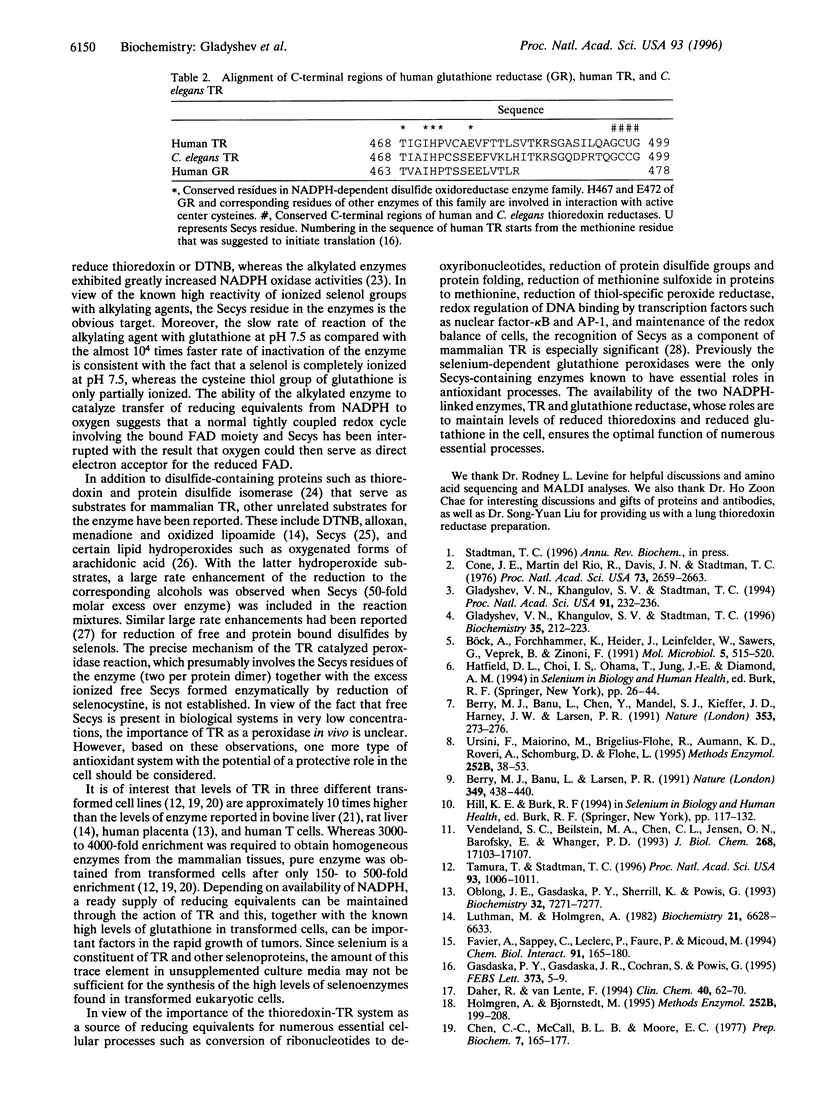
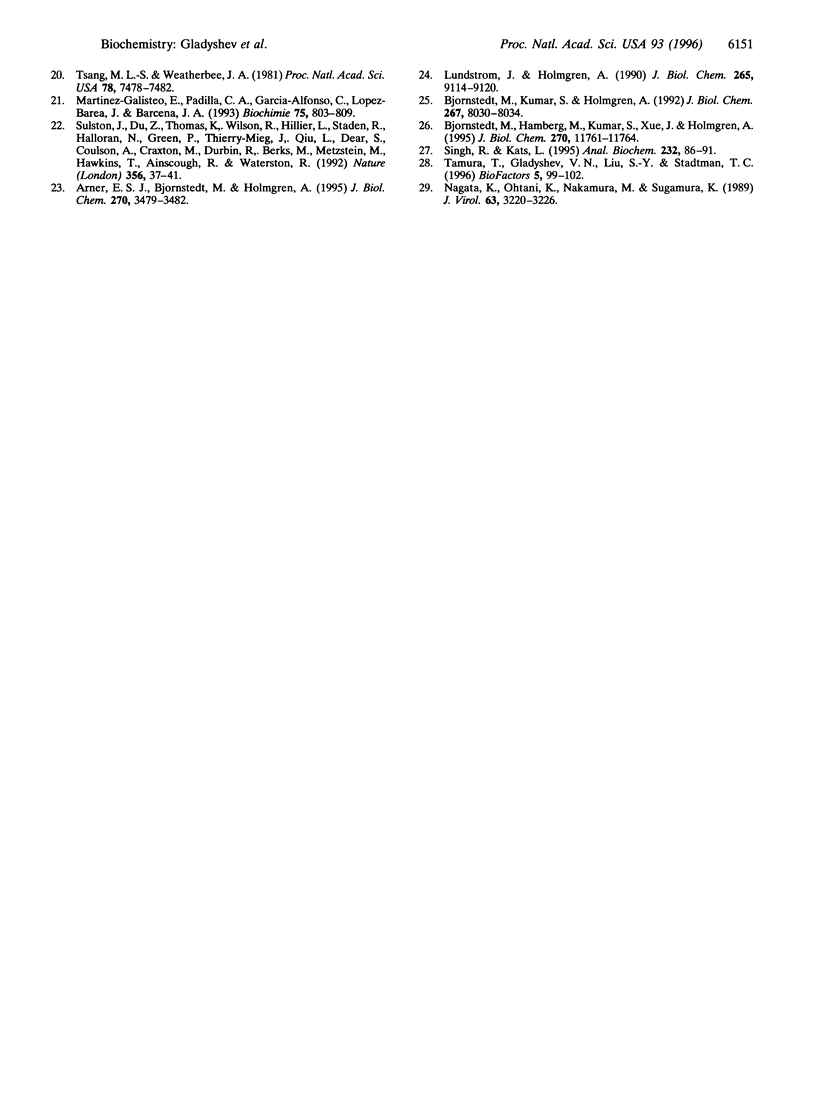
Images in this article
Selected References
These references are in PubMed. This may not be the complete list of references from this article.
- Arnér E. S., Björnstedt M., Holmgren A. 1-Chloro-2,4-dinitrobenzene is an irreversible inhibitor of human thioredoxin reductase. Loss of thioredoxin disulfide reductase activity is accompanied by a large increase in NADPH oxidase activity. J Biol Chem. 1995 Feb 24;270(8):3479–3482. doi: 10.1074/jbc.270.8.3479. [DOI] [PubMed] [Google Scholar]
- Berry M. J., Banu L., Chen Y. Y., Mandel S. J., Kieffer J. D., Harney J. W., Larsen P. R. Recognition of UGA as a selenocysteine codon in type I deiodinase requires sequences in the 3' untranslated region. Nature. 1991 Sep 19;353(6341):273–276. doi: 10.1038/353273a0. [DOI] [PubMed] [Google Scholar]
- Berry M. J., Banu L., Larsen P. R. Type I iodothyronine deiodinase is a selenocysteine-containing enzyme. Nature. 1991 Jan 31;349(6308):438–440. doi: 10.1038/349438a0. [DOI] [PubMed] [Google Scholar]
- Björnstedt M., Hamberg M., Kumar S., Xue J., Holmgren A. Human thioredoxin reductase directly reduces lipid hydroperoxides by NADPH and selenocystine strongly stimulates the reaction via catalytically generated selenols. J Biol Chem. 1995 May 19;270(20):11761–11764. doi: 10.1074/jbc.270.20.11761. [DOI] [PubMed] [Google Scholar]
- Björnstedt M., Kumar S., Holmgren A. Selenodiglutathione is a highly efficient oxidant of reduced thioredoxin and a substrate for mammalian thioredoxin reductase. J Biol Chem. 1992 Apr 25;267(12):8030–8034. [PubMed] [Google Scholar]
- Böck A., Forchhammer K., Heider J., Leinfelder W., Sawers G., Veprek B., Zinoni F. Selenocysteine: the 21st amino acid. Mol Microbiol. 1991 Mar;5(3):515–520. doi: 10.1111/j.1365-2958.1991.tb00722.x. [DOI] [PubMed] [Google Scholar]
- Chen C. C., McCall B. L., Moore E. C. Purification of thioredoxin reductase from the Novikoff rat tumor. Prep Biochem. 1977;7(2):165–177. doi: 10.1080/00327487708061633. [DOI] [PubMed] [Google Scholar]
- Cone J. E., Del Río R. M., Davis J. N., Stadtman T. C. Chemical characterization of the selenoprotein component of clostridial glycine reductase: identification of selenocysteine as the organoselenium moiety. Proc Natl Acad Sci U S A. 1976 Aug;73(8):2659–2663. doi: 10.1073/pnas.73.8.2659. [DOI] [PMC free article] [PubMed] [Google Scholar]
- Daher R., Van Lente F. Concanavalin A-bound selenoprotein in human serum analyzed by graphite furnace atomic absorption spectrometry. Clin Chem. 1994 Jan;40(1):62–70. [PubMed] [Google Scholar]
- Favier A., Sappey C., Leclerc P., Faure P., Micoud M. Antioxidant status and lipid peroxidation in patients infected with HIV. Chem Biol Interact. 1994 Jun;91(2-3):165–180. doi: 10.1016/0009-2797(94)90037-x. [DOI] [PubMed] [Google Scholar]
- Gasdaska P. Y., Gasdaska J. R., Cochran S., Powis G. Cloning and sequencing of a human thioredoxin reductase. FEBS Lett. 1995 Oct 2;373(1):5–9. doi: 10.1016/0014-5793(95)01003-w. [DOI] [PubMed] [Google Scholar]
- Gladyshev V. N., Khangulov S. V., Stadtman T. C. Nicotinic acid hydroxylase from Clostridium barkeri: electron paramagnetic resonance studies show that selenium is coordinated with molybdenum in the catalytically active selenium-dependent enzyme. Proc Natl Acad Sci U S A. 1994 Jan 4;91(1):232–236. doi: 10.1073/pnas.91.1.232. [DOI] [PMC free article] [PubMed] [Google Scholar]
- Gladyshev V. N., Khangulov S. V., Stadtman T. C. Properties of the selenium- and molybdenum-containing nicotinic acid hydroxylase from Clostridium barkeri. Biochemistry. 1996 Jan 9;35(1):212–223. doi: 10.1021/bi951793i. [DOI] [PubMed] [Google Scholar]
- Holmgren A., Björnstedt M. Thioredoxin and thioredoxin reductase. Methods Enzymol. 1995;252:199–208. doi: 10.1016/0076-6879(95)52023-6. [DOI] [PubMed] [Google Scholar]
- Lundström J., Holmgren A. Protein disulfide-isomerase is a substrate for thioredoxin reductase and has thioredoxin-like activity. J Biol Chem. 1990 Jun 5;265(16):9114–9120. [PubMed] [Google Scholar]
- Luthman M., Holmgren A. Rat liver thioredoxin and thioredoxin reductase: purification and characterization. Biochemistry. 1982 Dec 21;21(26):6628–6633. doi: 10.1021/bi00269a003. [DOI] [PubMed] [Google Scholar]
- Martínez-Galisteo E., Padilla C. A., García-Alfonso C., López-Barea J., Bárcena J. A. Purification and properties of bovine thioredoxin system. Biochimie. 1993;75(9):803–809. doi: 10.1016/0300-9084(93)90131-b. [DOI] [PubMed] [Google Scholar]
- Nagata K., Ohtani K., Nakamura M., Sugamura K. Activation of endogenous c-fos proto-oncogene expression by human T-cell leukemia virus type I-encoded p40tax protein in the human T-cell line, Jurkat. J Virol. 1989 Aug;63(8):3220–3226. doi: 10.1128/jvi.63.8.3220-3226.1989. [DOI] [PMC free article] [PubMed] [Google Scholar]
- Oblong J. E., Gasdaska P. Y., Sherrill K., Powis G. Purification of human thioredoxin reductase: properties and characterization by absorption and circular dichroism spectroscopy. Biochemistry. 1993 Jul 20;32(28):7271–7277. doi: 10.1021/bi00079a025. [DOI] [PubMed] [Google Scholar]
- Singh R., Kats L. Catalysis of reduction of disulfide by selenol. Anal Biochem. 1995 Nov 20;232(1):86–91. doi: 10.1006/abio.1995.9956. [DOI] [PubMed] [Google Scholar]
- Sulston J., Du Z., Thomas K., Wilson R., Hillier L., Staden R., Halloran N., Green P., Thierry-Mieg J., Qiu L. The C. elegans genome sequencing project: a beginning. Nature. 1992 Mar 5;356(6364):37–41. doi: 10.1038/356037a0. [DOI] [PubMed] [Google Scholar]
- Tamura T., Gladyshev V., Liu S. Y., Stadtman T. C. The mutual sparing effects of selenium and vitamin E in animal nutrition may be further explained by the discovery that mammalian thioredoxin reductase is a selenoenzyme. Biofactors. 1995;5(2):99–102. [PubMed] [Google Scholar]
- Tamura T., Stadtman T. C. A new selenoprotein from human lung adenocarcinoma cells: purification, properties, and thioredoxin reductase activity. Proc Natl Acad Sci U S A. 1996 Feb 6;93(3):1006–1011. doi: 10.1073/pnas.93.3.1006. [DOI] [PMC free article] [PubMed] [Google Scholar]
- Tsang M. L., Weatherbee J. A. Thioredoxin, glutaredoxin, and thioredoxin reductase from cultured HeLa cells. Proc Natl Acad Sci U S A. 1981 Dec;78(12):7478–7482. doi: 10.1073/pnas.78.12.7478. [DOI] [PMC free article] [PubMed] [Google Scholar]
- Ursini F., Maiorino M., Brigelius-Flohé R., Aumann K. D., Roveri A., Schomburg D., Flohé L. Diversity of glutathione peroxidases. Methods Enzymol. 1995;252:38–53. doi: 10.1016/0076-6879(95)52007-4. [DOI] [PubMed] [Google Scholar]
- Vendeland S. C., Beilstein M. A., Chen C. L., Jensen O. N., Barofsky E., Whanger P. D. Purification and properties of selenoprotein W from rat muscle. J Biol Chem. 1993 Aug 15;268(23):17103–17107. [PubMed] [Google Scholar]



